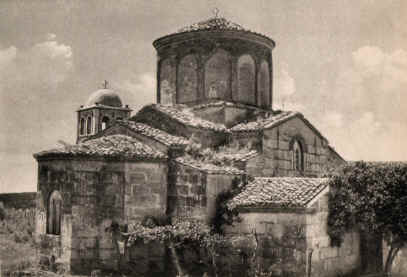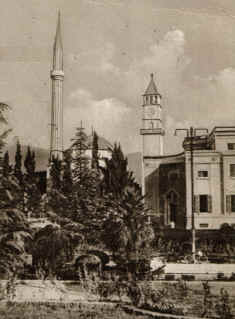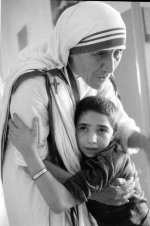

Religion
Even from a religious point of
view, Albania presents many aspects
of interest. It is opportune to
premise that the land of the eagles has almost always been characterized by a
pacific cohabitation between the Muslim, Catholic and Orthodox believers.
Albania can in fact be considered as a country where there is a great religious
tolerance. On the contrary, the
three greater religions probably favoured the conservation of a common national
identity, saving the Albanians by the assimilation processes that their foreign
neighbours had tried to put into effect. In
fact, the spread of Catholicism defended Albania by the pressure of the
Byzantine empire ;
and, subsequently, the spread of Islam (often imposed ) brutally
refrained the expansionistic aims of the Slavs.
On this matter, it is important to notice that even the Albanian Islam
became more and more different from the Muslim central faith (the so-called
" UNNA "). Many Albanian Muslims preferred to follow faithfully their
own local spiritual leaders, the MUFTI, but also the " dervish " sect of the Bektashi (that derives by he name of the
founder Hagi Veli Bektasch ) collected the adhesions of many adepts.
Finally the declaration of autocephaly of the Orthodox Church (12 April
1937 ) helped to save the faith in Orthodoxy and in the national autonomy.


Pojani - Christian Church
Tirana - Mosque
In the XX century, religion was
almost explicitly connected to the liberation process.
Before the proclamation of independence in 1912, in Albania people
assisted to the spreading of a religious nationalism that had origin in that
instinct of conservation and of survival of the nation that has always been a
characteristic of the Albanians . As
the man of letters Pashko Vasa
wrote : " the religion of the
Albanians is their Albanian
identity ". With the “
Rilindja “ (the Rebirth - the national renaissance that begun in the second
half of the nineteenth century, after the period of the Ottoman invasion) the
national feeling revealed to be a mighty glue, an element of cohesion and union
between the four great religious confessions of the Country:
the Muslim Sunnite religion, the Orthodox and the Catholic Churches and
the "Bektash" Dervish sect . This
unity was also possible because, effectively, these religions lived in a
spirit of mutual respect and great tolerance.
On the contrary , many
occasions of solidarity took place, inspired by the unity of the nation, that
let fade into the background also their deep doctrinal and theoretic divergences.
It is noteworthy the fact that
during the second World war and the horrors of the Holocaust, the Albanians not
only protected their fellow countrymen of Jewish religion, but gave
hospitality also to the Jews escaped from Austria, Serbia and Greece.
The generosity of these (indifferently Muslim and Christian)
Albanians that contributed to the salvation of the Jew refugees have been
solemnly commemorated in the “ Righteous Among the Nations “ during
the " Yad Vashem Memorial " in Jerusalem, moreover their names are
recorded in the famous " Rescuers Wall " in the " US Holocaust Memorial
Museum " of Washington.
Even after a superficial study of
this people, it may hence be inferred that their pride , their sense of
belonging to their culture and their faith are amazing .
And probably it has been this last element that has mostly favoured
the national unity and that has kept united a people that others wanted to divide.
-----------------------------------
" we do not make
religious distinctions... we should convince ourselves that we are all brothers
of one nation, one stock, one blood, we are the sons of those valiant persons who took shelter in this land with honour, heroism and wisdom.
And for this, we should
cordially love us, and mutually honour us without difference, we should all
join together with the " besa " (the promise ) for the future
and the glory of Albania"
Pashko Vasa, " Albania and the Albanians ", Corigliano Calabro, Italy, 1916
In memory of Papŕs Giuseppe
Ferrari who in Bari, in the centre of S. Giovanni Crisostomo, dedicated all its
life to set up religious and intercultural connections and relationships between
Italy and Albania.
In memory of AGNES GONXHA BOJAXHIU, a magnificent and extraordinary example of life for all of us , a woman born in Skopje, belonging to the large Albanian community present in Macedonia,
…best known as MOTHER TERESA

" I'm just a pencil, in God's hands "
Mother Teresa
One of Mother Teresa's dreams, comes true
Hospital "Nostra Signora del Buon Consiglio"
Rruga
e Kavajes
96100 Tirana
Tel. 00355.42.23906 - Fax 00355.42.31125
Person Responsible: P. Mariano Passerini
IF YOU WANT TO CONTRIBUTE TO THE COMPLETION OF THE HOSPITAL
PLEASE PAY INTO THIS BANK ACCOUNT
C/C BANCARIO N.
50005/30
BANCA DI ROMA Ag. 18 - Roma
Pro Ospedale
"Nostra Signora del Buon Consiglio"
ABI: 3002.3 CAB: 05037.7
OR THIS POST OFFICE ACCOUNT
C/C POSTALE N.
26616037
TO
"Amici Fondazione Nostra Signora del Buon Consiglio"
ONLUS
(No-profit making religious association )
BIBLIOGRAPHY
Robert Elsie , A Dictionary of Albanian Religion, Mythology, and Folk Culture, November 2000.
R.
MOROZZO DELLA ROCCA, NAZIONE
E RELIGIONE IN ALBANIA (1920 - 1944),
Bologna.
LORENZO TACCHELLA, ILCATTOLICESIMO IN ALBANIA NEI SECOLI XVII E XVIII , Biblioteca Capitolare di Verona, Verona, 1984.
LORENZO TACCHELLA, LE ANTICHE SEDI EPISCOPALI LATINE, GRECHE, E BULGARE DELL'ALBANIA ETNICA E DELLA MACEDONIA, Biblioteca dell'accademia Olubrense, Milano, 1990.
ELEUTERIO F. FORTINO, LA FEDE CRISTIANA. BESA E KRISHTERË,, SCUOLA TIPOGRAFICA ITALO-ORIENTALE "S. NILO", Grottaferrata-Roma, 1992.
ELEUTERIO F. FORTINO, LA CHIESA BIZANTINA ALBANESE IN CALABRIA. TENSIONI E COMUNIONE, BIOS, 1994.
Testi di GEORGHIOS K. GHIAKOUMIS; fotografie di GREGORIS VLASSA, MONUMENTI BIZANTINI IN ALBANIA.
AA.VV., 1946-1996. GESUITI MARTIRI IN ALBANIA, SAN FEDELE EDIZIONI, 1996.
CARMELO
LA ROSA, IL SAPORE
DEL PANE. FRAMMENTI DI CHIESA IN ALBANIA, LA
MERIDIANA ED., MOLFETTA (BA), 1995.
San Fedele Edizioni